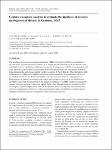Capture–recapture analysis to estimate the incidence of invasive meningococcal disease in Germany, 2003
Schrauder, Annette
Claus, Hermann
Elias, Johannes
Vogel, Ulrich
Haas, Walter
Hellenbrand, Wiebke
The incidence of invasive meningococcal disease (IMD) in Germany in 2003 was estimated by the two-source capture–recapture method. As a unique personal identifier was unavailable, cases with IMD tested at the National Reference Centre for Meningococci (NRZM) were matched with cases reported to the Robert Koch Institute (RKI) through the statutory surveillance system by using demographic and disease-specific variables common to both datasets. The estimated overall incidence was 1.1 IMD cases/100 000 inhabitants, with a sensitivity of ascertainment of 64.8% for NRZM and 89.4% for RKI. Case-fatality rate was estimated at 8.8%. Adjustment for heterogeneity of capture according to age, region and serogroup observed in the NRZM (but not RKI) source had minimal effect on the estimated incidence. The IMD incidence estimated by capture–recapture analysis is thus only slightly higher than through statutory surveillance data. As a degree of positive dependence between the systems cannot be ruled out, this estimate may still be an underestimate. However, under ascertainment appears insufficient to explain the low incidence of IMD in Germany compared to other European countries.
No license information

